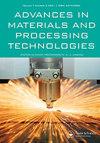Investigation of fatigue cracking in aluminium 7075 alloys and the role of heat treatment
IF 2.1
Q3 MATERIALS SCIENCE, MULTIDISCIPLINARY
Advances in Materials and Processing Technologies
Pub Date : 2023-10-12
DOI:10.1080/2374068x.2023.2264576
引用次数: 0
Abstract
The unique properties of aluminium alloys and their high strength-to-weight ratio make them the preferred choice for aircraft design. However, fatigue cracking in ageing fleets remains significant. This study investigates microstructural cracking of cooled and heat-treated Al 7075–0, T6, and T7 alloys used in airframes and stringers. To study the effect of heat treatment, medium voltage test pieces were used according to the guidelines of ASTM E647. Scanning Electron Microscopy (SEM) was used to observe the crack surface morphology. The results show that Al 7075-T7 exhibits higher resistance to the Fatigue crack growth (FCG) threshold than Al 7075-O and T6. In the case of the quenched Al 7075-O, the fatigue performance remains constant for samples oriented with a perpendicular and countersunk rivet hole. SEM analysis of fatigue cracking surface indicates that the microcracks leading to fracture originate from inclusion zones, secondary stage grains, and microstructural defects. In addition, as the heat treatment condition increased from O to T6 to T7, the area of the semi-subdivision planes and the width of the fatigue bands initially increased and then decreased. The final fault zones exhibit dimpled properties, with increasing size and deeper changing depth as heat treatment annealing progresses from O to T6 to T7. In summary, the study highlights the outstanding fatigue resistance of Al 7075-T7 and provides valuable insights into the microstructural aspects of fatigue cracking in aircraft alloys subjected to different heat treatments. These results contribute to the understanding and managing of ageing fleets, supporting the development of more reliable aircraft designs.7075铝合金疲劳开裂及热处理作用的研究
铝合金的独特性能及其高强度重量比使其成为飞机设计的首选。然而,老化机队的疲劳开裂问题仍然很严重。本研究研究了用于机身和弦架的冷却和热处理的Al 7075-0、T6和T7合金的显微组织开裂。为了研究热处理的效果,根据ASTM E647的指导方针使用中压试样。采用扫描电镜(SEM)观察裂纹表面形貌。结果表明:Al 7075-T7比Al 7075-O和T6具有更高的抗疲劳裂纹扩展阈值;在Al 7075-O淬火的情况下,用垂直沉钉孔取向的试样的疲劳性能保持不变。疲劳裂纹表面的SEM分析表明,导致断裂的微裂纹主要来源于夹杂物区、次生晶粒和显微组织缺陷。另外,随着热处理条件从0到T6再到T7的增加,半细分面面积和疲劳带宽度先增大后减小。从0 ~ T6到T7,随着热处理退火的进行,最终断裂带呈现出韧窝的特征,尺寸增大,深度变化更深。总之,该研究突出了Al 7075-T7优异的抗疲劳性能,并为不同热处理下飞机合金疲劳开裂的微观组织方面提供了有价值的见解。这些结果有助于了解和管理老化的机队,支持更可靠的飞机设计的发展。
本文章由计算机程序翻译,如有差异,请以英文原文为准。
求助全文
约1分钟内获得全文
求助全文
来源期刊

Advances in Materials and Processing Technologies
MATERIALS SCIENCE, MULTIDISCIPLINARY-
CiteScore
3.90
自引率
27.30%
发文量
222
 求助内容:
求助内容: 应助结果提醒方式:
应助结果提醒方式:


